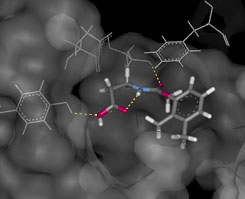 | Ligand in AChE active site.
Docking example from OTAVAchemicals Acetylcholinesterase library.
The detection of H-bonding between ligand and key AChE residues (Gly118, Gly119, Tyr130 and Ser200) was used for the library preparation.
|
Over the last decade, acetylcholinesterase inhibitors (AChEIs), agents that inhibit acetylcholinesterase (AChE) activity, have been the mainstays of Alzheimer's Disease (AD) therapy. They work by increasing acetylcholine concentrations, and thus their availability for synaptic transmission. Previously marketed agents in this class, in the U.S. and Europe, include tacrine (Cognex, Parke Davis), donepezil (Aricept, Pfizer), and rivastigmine (Exelon, Novartis). In clinical trials, most of these products were shown to improve cognitive function modestly and to have acceptable tolerability profiles. The exception is tacrine, which is rarely used because of its potential to induce severe hepatic complications.
Unfortunately, the current therapies for AD are only symptomatic and do not halt the progression of the disease. Nonetheless, these agents are the only compounds approved for the treatment of AD; therefore, the development of newer agents that are designed to be more effective and have fewer side effects is a high priority.
The focused libraries, including docking scores and drug-like properties, are available on request.
Feel free to contact us!
Martin S. Maltz, RPh, MS and Harold L. Kirschenbaum, MS, PharmD. Galantamine: A New Acetylcholinesterase Inhibitor for the Treatment of Alzheimer’s Disease. P&T, 2002, Vol. 27 No. 3, 135-138.
|
 HOME
HOME ABOUT
ABOUT
 SERVICES
SERVICES
 PRODUCTS
PRODUCTS
 Targeted Libraries
Targeted Libraries
 Biochemicals
Biochemicals
 RESEARCH
RESEARCH
 DOWNLOADS
DOWNLOADS ORDERING
ORDERING
 CONTACTS
CONTACTS

